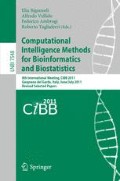Abstract
Motif finding in nucleotide sequences for the discovery of over–represented transcription factor binding sites is a very challenging problem, both from the computational and the experimental points of view. Transcription factors in fact recognize very weakly conserved sequence elements, that in typical applications are very hard to discriminate against random sequence similarities. Recent advances in technology like ChIP-Seq can generate better datasets to be investigated, in which the degree of conservation of binding sites is higher: on the other hand, the size itself of the datasets has posed new challenges for the design of efficient algorithms able to produce results in reasonable time. In this work we present an updated version of our algorithm Weeder, in which time and space requirements are significantly reduced and, moreover, also the accuracy of the results is notably improved.
Access this chapter
Tax calculation will be finalised at checkout
Purchases are for personal use only
Preview
Unable to display preview. Download preview PDF.
References
Lemon, B., Tjian, R.: Orchestrated response: a symphony of transcription factors for gene control. Genes. Dev. 14, 2551–2569 (2000)
Stormo, G.D.: DNA binding sites: representation and discovery. Bioinformatics 16, 16–23 (2000)
Pavesi, G., Mauri, G., Pesole, G.: In silico representation and discovery of transcription factor binding sites. Brief Bioinform. 5, 217–236 (2004)
Collas, P., Dahl, J.A.: Chop it, ChIP it, check it: the current status of chromatin immunoprecipitation. Front Biosci. 13, 929–943 (2008)
Mardis, E.R.: ChIP-seq: welcome to the new frontier. Nat. Methods 4, 613–614 (2007)
Pavesi, G.: Motif finding from Chips to ChIPs. In: Elnitski, L., Piontkivska, H., Welch, L.R. (eds.) Advances in Genomic Sequence Analysis and Pattern Discovery. World Scientific Publishing Co. (2011)
Mercier, E., Droit, A., Li, L., Robertson, G., Zhang, X., Gottardo, R.: An integrated pipeline for the genome-wide analysis of transcription factor binding sites from ChIP-Seq. PLoS One 6, e16432 (2011)
Tompa, M., Li, N., Bailey, T.L., Church, G.M., De Moor, B., Eskin, E., Favorov, A.V., Frith, M.C., Fu, Y., Kent, W.J., Makeev, V.J., Mironov, A.A., Noble, W.S., Pavesi, G., Pesole, G., Rgnier, M., Simonis, N., Sinha, S., Thijs, G., van Helden, J., Vandenbogaert, M., Weng, Z., Workman, C., Ye, C., Zhu, Z.: Assessing computational tools for the discovery of transcription factor binding sites. Nat. Biotechnol. 23, 137–144 (2005)
Sagot, M.-F.: Spelling Approximate Repeated or Common Motifs Using a Suffix Tree. In: Lucchesi, C.L., Moura, A.V. (eds.) LATIN 1998. LNCS, vol. 1380, pp. 111–127. Springer, Heidelberg (1998)
Pavesi, G., Mereghetti, P., Mauri, G., Pesole, G.: Weeder Web: discovery of transcription factor binding sites in a set of sequences from co-regulated genes. Nucleic Acids Res. 32, W199–W203 (2004)
Ettwiller, L., Paten, B., Ramialison, M., Birney, E., Wittbrodt, J.: Trawler: de novo regulatory motif discovery pipeline for chromatin immunoprecipitation. Nat. Methods 4, 563–565 (2007)
Linhart, C., Halperin, Y., Shamir, R.: Transcription factor and microRNA motif discovery: the Amadeus platform and a compendium of metazoan target sets. Genome Res. 18, 1180–1189 (2008)
Zhang, Y., Waterman, M.S.: DNA sequence assembly and multiple sequence alignment by an Eulerian path approach. In: Cold Spring Harb. Symp. Quant. Biol., vol. 68, pp. 205–212 (2003)
Zerbino, D.R., Birney, E.: Velvet: algorithms for de novo short read assembly using de Bruijn graphs. Genome Res. 18, 821–829 (2008)
Martianov, I., Choukrallah, M.A., Krebs, A., Ye, T., Legras, S., Rijkers, E., Van Ijcken, W., Jost, B., Sassone-Corsi, P., Davidson, I.: Cell-specific occupancy of an extended repertoire of CREM and CREB binding loci in male germ cells. BMC Genomics 11, 530 (2010)
Bailey, T.L.: DREME: motif discovery in transcription factor ChIP-seq data. Bioinformatics 27, 1653–1659 (2011)
Author information
Authors and Affiliations
Editor information
Editors and Affiliations
Rights and permissions
Copyright information
© 2012 Springer-Verlag Berlin Heidelberg
About this paper
Cite this paper
Zambelli, F., Pavesi, G. (2012). A Faster Algorithm for Motif Finding in Sequences from ChIP-Seq Data. In: Biganzoli, E., Vellido, A., Ambrogi, F., Tagliaferri, R. (eds) Computational Intelligence Methods for Bioinformatics and Biostatistics. CIBB 2011. Lecture Notes in Computer Science(), vol 7548. Springer, Berlin, Heidelberg. https://doi.org/10.1007/978-3-642-35686-5_17
Download citation
DOI: https://doi.org/10.1007/978-3-642-35686-5_17
Publisher Name: Springer, Berlin, Heidelberg
Print ISBN: 978-3-642-35685-8
Online ISBN: 978-3-642-35686-5
eBook Packages: Computer ScienceComputer Science (R0)

